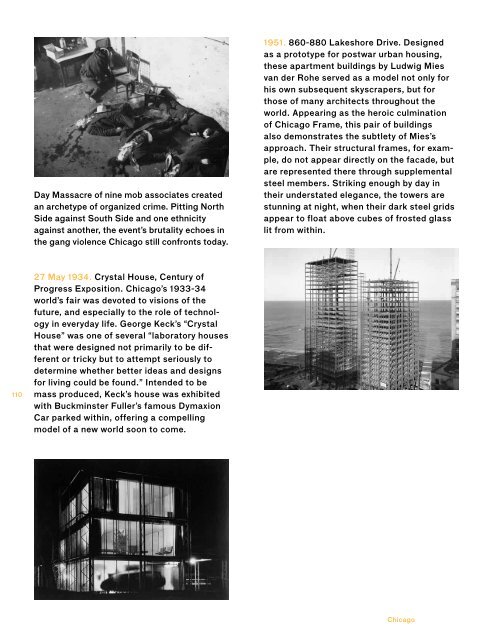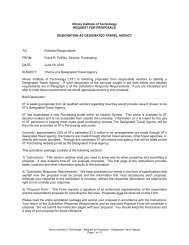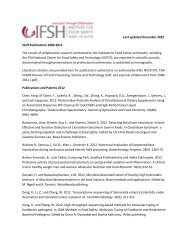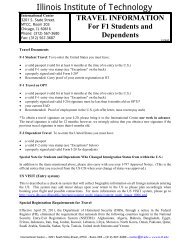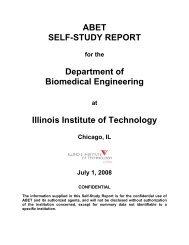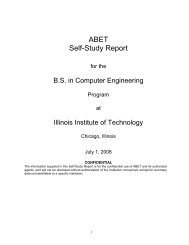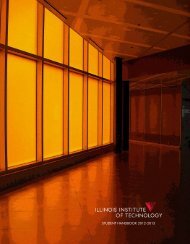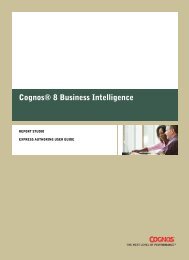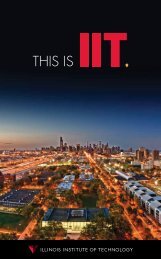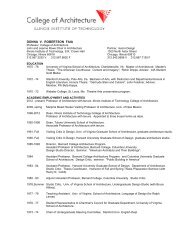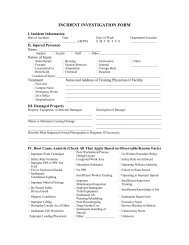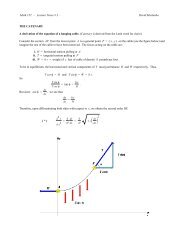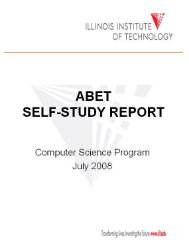Nowness - Illinois Institute of Technology
Nowness - Illinois Institute of Technology
Nowness - Illinois Institute of Technology
You also want an ePaper? Increase the reach of your titles
YUMPU automatically turns print PDFs into web optimized ePapers that Google loves.
110<br />
Day Massacre <strong>of</strong> nine mob associates created<br />
an archetype <strong>of</strong> organized crime. Pitting North<br />
Side against South Side and one ethnicity<br />
against another, the event’s brutality echoes in<br />
the gang violence Chicago still confronts today.<br />
27 May 1934. Crystal House, Century <strong>of</strong><br />
Progress Exposition. Chicago’s 1933-34<br />
world’s fair was devoted to visions <strong>of</strong> the<br />
future, and especially to the role <strong>of</strong> technology<br />
in everyday life. George Keck’s “Crystal<br />
House” was one <strong>of</strong> several “laboratory houses<br />
that were designed not primarily to be different<br />
or tricky but to attempt seriously to<br />
determine whether better ideas and designs<br />
for living could be found.” Intended to be<br />
mass produced, Keck’s house was exhibited<br />
with Buckminster Fuller’s famous Dymaxion<br />
Car parked within, <strong>of</strong>fering a compelling<br />
model <strong>of</strong> a new world soon to come.<br />
1951. 860-880 Lakeshore Drive. Designed<br />
as a prototype for postwar urban housing,<br />
these apartment buildings by Ludwig Mies<br />
van der Rohe served as a model not only for<br />
his own subsequent skyscrapers, but for<br />
those <strong>of</strong> many architects throughout the<br />
world. Appearing as the heroic culmination<br />
<strong>of</strong> Chicago Frame, this pair <strong>of</strong> buildings<br />
also demonstrates the subtlety <strong>of</strong> Mies’s<br />
approach. Their structural frames, for example,<br />
do not appear directly on the facade, but<br />
are represented there through supplemental<br />
steel members. Striking enough by day in<br />
their understated elegance, the towers are<br />
stunning at night, when their dark steel grids<br />
appear to float above cubes <strong>of</strong> frosted glass<br />
lit from within.<br />
28 August 1968. Police Riot, Democratic<br />
National Convention. “As long as I am mayor,<br />
there will be law and order in Chicago.<br />
Nobody is going to take over this city.” So<br />
boasted Richard J. Daley on the eve <strong>of</strong> the<br />
convention he had brought to the city. In the<br />
preceding year, while other cities rioted and<br />
burned, Chicago had remained quiet. The<br />
calm did not hold—confrontations between<br />
protesters and police exploded in chaos and<br />
cruelty. The conflict over race, wealth, military<br />
action, and political power played out<br />
violently on a national stage, and was broadcast<br />
live from Mayor Daley’s Chicago.<br />
6 May 1968. John Hancock Center Tops Out.<br />
Designed by Bruce Graham and engineered<br />
by Fazlur Khan, both <strong>of</strong> SOM, the 100-story<br />
tall John Hancock Center is a vertical city<br />
within the city, containing <strong>of</strong>fices, condominiums,<br />
restaurants, shops, and parking.<br />
Groundbreaking at the time <strong>of</strong> its completion,<br />
the tower debuted Khan’s “trussed tube”<br />
structural system. This novel approach used<br />
an x-braced external steel frame to efficiently<br />
distribute the extreme wind and gravity loads<br />
generated by such a tall building. Research<br />
proving this technique’s efficiency was carried<br />
out by IIT graduate student Mikio Sasaki under<br />
the guidance <strong>of</strong> Kahn and Myron Goldsmith.<br />
16 July 2004. Opening Day <strong>of</strong> Millennium<br />
Park. Constructed over the train yards that<br />
once defined the city, Millennium Park is<br />
emblematic <strong>of</strong> Chicago’s shift from a city<br />
defined by modern industry, to one determined<br />
by finance, culture, tourism, and lifestyle. New<br />
landmarks such as Frank Gehry’s Jay Pritzker<br />
Pavilion and Anish Kapoor’s Cloud Gate have<br />
played an important role in redefining the<br />
“imageability” <strong>of</strong> downtown Chicago. But<br />
beneath these structures and the engineered<br />
prairie in which they sit, the Metra/<strong>Illinois</strong><br />
Central tracks remain in use, channeling commuters<br />
and tourists to feed the commerce<br />
that underpins the city’s venture into a global,<br />
post-material conception <strong>of</strong> urbanity.<br />
111<br />
Chicago<br />
Chicago


